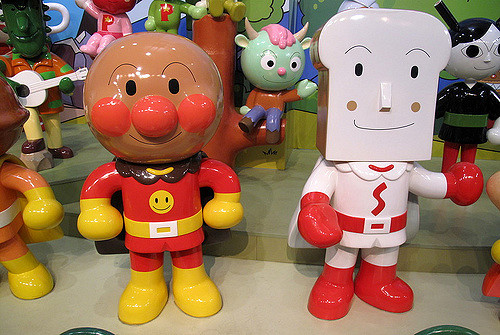Sep 27, 2018
Down With The Kids (TV Shows)
For children making friends can be so much about shared knowledge and experience. This can be difficult when moving to a new country where cultural references are different (and I will never forget the sting of being told, as I sat outside of my new American home after having moved from England that the MC Hammer album I was playing on my ghettoblaster was ‘played out’).
This issue can be doubly tricky when things are in a different language. But there are plenty of great TV shows out there that you can watch with your children that will help them to not only have something that they can recognize with friends at playgroup or school but also help them learn Japanese. And who knows, you may learn something too.
Anpanman – アンパンマン
Imagine if Superman had a bun filled with red azuki paste for a head, and you kind of have Anpanman. Anpanman has been going since the early 1970s but remains endearingly popular with young children to this day as they follow his battles against his arch-nemesis, Baikinman.
Baikinman regularly attempts to disrupt Anpanman’s bread-based friends, often by stealing tasty treats by deception with the help of his right-hand girl Dokinchan. Though Baikinman may temporarily get one over Anpanman by squirting the titular hero’s pastry head with water, friendly baker Uncle Jam quickly cooks up a new head, meaning that, with an ‘Anpunch’, Anpanman defeats his enemy and wins the day.
Purikyua – プリキュア
Known as ‘Glitter Force’ outside of Japan, Purikyua, or Precure, is a show about magical girls given special powers that allow them to transform into legendary warriors known as the Pretty Cure.
Though Nagisa and Honoka attend the same school, they have very little in common, until one day a shower of shooting stars brings two visitors into their lives: Mippuru and Meppuru, refugees from the Garden of Light, a planet that has been conquered by Darkness. With their new powers, Nagisa and Honoka become Cure Black and Cure White, magical defenders of the light, and together, they are Pretty Cure, using their magical powers to battle the evil dark forces.
Detective Conan – 名探偵コナン Meitantei Konan
Thanks to its closeness to the name of author Arthur Conan Doyle, this top-rated show is known as ‘Case Closed’ in English, but this is no Sherlock Holmes rip-off.
After prodigious sixteen-year-old detective Shinichi Kudo helps the Tokyo police to solve a murder case, members of an evil crime syndicate, the Black Organization, try to poison him to death. However, rather than killing him, the poison had an unusual side-effect, shrinking him to the size of a six-year-old.
To protect himself and his friends, in particular, Ran, his best friend and the object of his affections since kindergarten, Shinichi assumed the persona of elementary school pupil Conan Edogawa. In this guise, Shinichi helps Ran’s bungling detective father in the hope that one day he will expose the crimes of the Black Organization and then acquire an antidote that will return him to his teenage form.
Doraemon – ドラえもん
Along with Anpanman, Doraemon is perhaps the most popular of Japanese children’s TV shows.
The story centers around Nobita, a somewhat lonely young boy who suffers from poor grades and frequent bullying. However, things take a turn for the better when, in the 24th century, one of his ancestors sends back in time Doraemon, a robotic cat, to protect and guide him.
The pair has many adventures, often helped by the magical tools that Doraemon can produce from his four-dimensional pocket, the most famous of which is the ‘doko-demo-door,’ a doorway that allows the user to travel to anywhere he or she wishes.
Crayon Shin-chan – クレヨンしんちゃん
Crayon Shin-chan follows the adventures of the five-year-old Shinnosuke “Shin” Nohara. As Shin is something of a strange lad, much of the humor of this quite off-the-wall show is centered around his occasionally weird, unnatural and inappropriate use of language, as well as his naughty behavior.
This means that it can be difficult for non-Japanese to come to grips with some of the humor. For example, when Shin-chan annoys his parents when returning home by saying “Welcome back” (“おかえりなさい” “okaeri nasai”) instead of “I am home” (“ただいま” “Tadaima”) – however more slapstick elements, such as trying to eat snow with chopsticks or frequently flashing his backside, are more universal.
PythagoraSwitch -ピタゴラスイッチ
By far and away my favorite show on Japanese TV, PythagoraSwitch is an NHK program that is ostensibly aimed at very young children to help them learn to count read and speak, much in the vein of Sesame Street. However, this show is perhaps more engaging, more innovative and more charming than even the home of Bert and Ernie.
It is somewhat difficult to explain what PythagoraSwitch is, other than each episode os a selection of short scenes of stop-animation teaching names of animals, words for Japanese counters or amazing logic-defying Mousetrap-esque tricks. It is a show that I cannot do justice to, and it takes watching to appreciate. And once you start, you may never stop.
Mark Guthrie
Photo: by Shibuya246 (CC BY-SA 2.0) via flickr.com



About the author